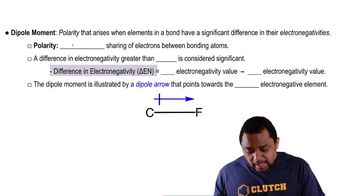Here are the essential concepts you must grasp in order to answer the question correctly.
Dipole Moment
The dipole moment is a measure of the separation of positive and negative charges in a molecule, represented as a vector. It indicates the polarity of a bond or molecule, with a larger dipole moment signifying greater polarity. The overall dipole moment of a molecule is determined by the vector sum of all individual bond dipoles, taking into account both their magnitudes and directions.
Recommended video:
Electronegativity and Polarity
Electronegativity is the tendency of an atom to attract electrons in a chemical bond. When two atoms in a molecule have different electronegativities, the shared electrons are pulled closer to the more electronegative atom, creating a polar bond. If the molecule has an asymmetrical arrangement of these polar bonds, it will have a nonzero dipole moment, indicating overall molecular polarity.
Recommended video:
Molecular Geometry and Dipole Cancellation
The geometry of a molecule significantly affects its dipole moment. In symmetrical molecules, such as tetrahedral AB4, the bond dipoles can cancel each other out due to their equal magnitude and opposite directions. This results in a net dipole moment of zero, meaning the molecule is nonpolar despite having polar bonds.
Recommended video:
Molecular Geometry with Two Electron Groups

 Verified step by step guidance
Verified step by step guidance


